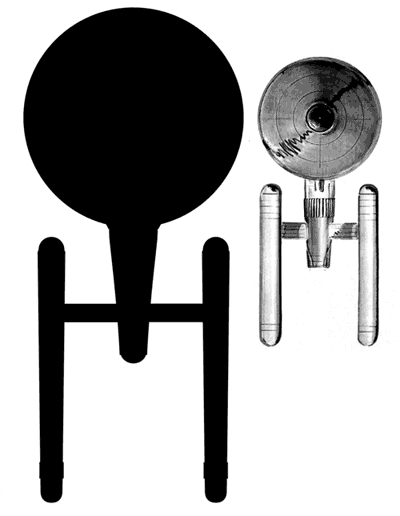Right... (If you did read my earlier, posts, I thought both figures were valid. So you can have your cake and eat it too, eh?

)
Speaking of Walter Matthew Jefferies... did he indicate Gross Tons, Deadweight Metric Tons or Gross Weight Metric Tons? Seriously, since I would hate to incorrectly quote you quoting Jefferies and assume the unit of measure and start this thread all up again

Edit: So a little digging turns up that Jefferies might have been designing the Enterprise as a 540' ship and it got upsized? Did the 190,000 metric ton (gross weight/deadweight/gross ton/whatever) come before this supposed 540' length or after? Because if it was originally 190,000 Metric Tons for 540' (assumed total weight/mass) then the ship's average density
goes back up to 4800 kg/m3 which is pretty close in density to the 947' ship at ~900,000 gross tons mass.
Well, if you are seriously asking about where Jefferies came up with his figures, I'd point out that the weight was determined in comparison to the Forrestal class carriers (because it was approximately the same size). So whatever version of
ton the US Navy would have been using in their descriptions of that class is most likely what Jefferies meant.
I've been asked
Why the Forrestal class? My guess is that in the pre-internet days of 1964, it was easier to get information on the Forrestal class carriers than the Kitty Hawk, Constellation or Enterprise (all three of which were launched in 1961 as I recall).
And as long as we are on the subject, the 200 plus crew compliment was most likely a math error. The size change of the Enterprise came in October of 1964, nearly doubling the overall length. The 200 plus number most likely represented a 4x increase in the size of the crew, rather than the 8x increase that would have reflected the actual interior volume change.
The error is understandable when you consider that on the page, the increase is 2D.
As for why Jefferies put as much thought into a fictional (TV) space ship, I'd point out that he had a lot of time to think about the Enterprise between the Fall of 1964 and the spring of 1966 (when series production started up). That is far more lead in time than most SciFi TV series would have... and Jefferies seemed to have put that time to good use.
As for the little digging, are you asking me to bring up that misconception that people have clung onto again here?
There were plans drawn up for a smaller ship in October of 1964 (and was being compared to a navy cruiser as I recall), but those plans were scrapped. The final design for the models was the larger size (938 feet in length), and
that design was then compared to the Forrestal class carriers when Jefferies was working out his original numbers.
The smaller size Enterprise was also designed to land the saucer every week (pre-transporters), and would not have weighed more than a modern aircraft carrier while being smaller than a cruiser. Atmospheric flight was part of the original design of the saucer section.
Jefferies hadn't finished the final plans by the beginning of November and the models needed to be started. Because many of the parts of the model (on the page) were the same size and shape, Richard Datin was given a set of the earlier plans to get started with on November 4, 1964. On those plans Jefferies wrote notes pointing out which parts to use and which not to use. The reason the primary hull curves on the 33 inch model are different from the 11 foot model is that that part was started before Datin had gotten the final plans on November 7, 1964.
Additionally, because the final plans for the models had no hull markings on them, rather than draw the plans up again, Jefferies used one of the earlier plans for drawing up those markings. Some of the callouts on those plans were mistaken as hull markings and made it onto the secondary hull of the 33 inch model. Because they added detail which Roddenberry was constantly asking for more of (and no one ever thought anyone would be able to read them anyways), they were left on the smaller model and put on the larger one when it was built.
The problem I see is that a lot of people today believe that copies come easy, where as back in 1964 the idea was not to waste anything. Earlier sketches of the smaller design were pressed into service on the bridge in displays. Why? Because they were already drawn. This would happen again in TMP where
drawings of the Phase II Enterprise appear all over the bridge rather than the TMP Enterprise.
As for the
947 foot length...later when Jefferies was arranging all the same parts of the Enterprise, he arranged them a little differently (giving him a slightly longer length). The dimensions of parts themselves stayed constant though. Back in the 1960s, people did a lot of redrawing and this introduced small changes like that. That is why using the overall length of the Enterprise is a poor gauge (as it is a cluster of smaller elements)... I use the diameter of the primary hull as my primary reference for scale (as it is a solid element).

The sad thing is, I've provided tons of this type of information for people to use before... and they don't. The historical analysis I just gave was a result of my efforts to reverse engineer the 33 inch model and the original plans for the Enterprise.
Did you look at any of that research before asking your questions?



 )
)


 )
)

